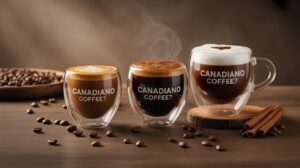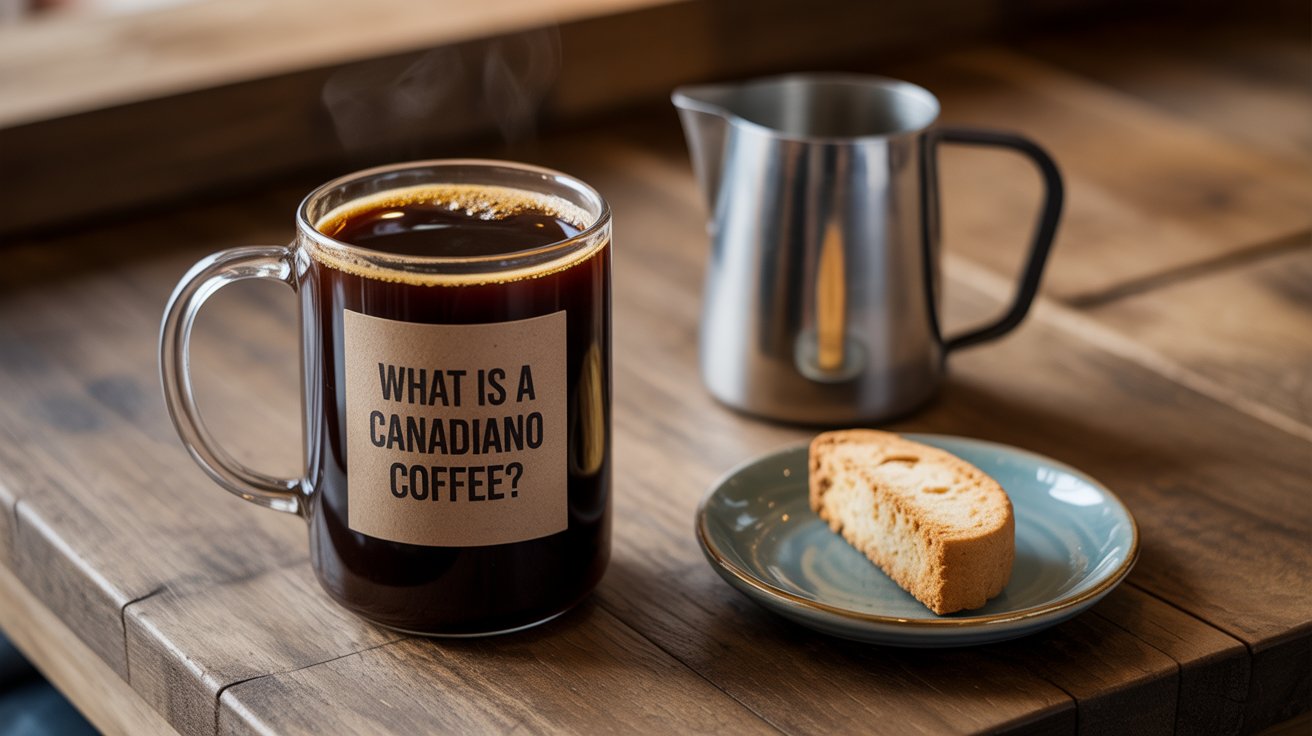A Canadiano coffee is either (1) a patriotic rebrand of the classic Americano—espresso topped with hot water—used by Canadian cafés as a subtle protest against U.S. trade politics, or (2) a stronger variant where a shot of espresso is poured into brewed drip coffee.
In short: it’s both a statement in a cup and a caffeinated twist on a familiar favorite.
The Real Story Behind the Canadiano
The Canadiano didn’t start as a recipe. It started as a statement.
In British Columbia, roaster Kicking Horse Coffee swapped “Americano” for “Canadiano” in 2025. The move quickly spread across independent cafés in Toronto, Ottawa, and beyond.
Why? Rising tensions over U.S. tariffs on Canadian goods. According to The Washington Post, baristas saw the rename as a form of “quiet rebellion”—a small but symbolic act of national pride served daily across the counter.
The New York Post went further, calling it Canada’s “quiet revenge against the U.S.—through coffee.” Other outlets, like Cadena SER, reported on how renaming drinks became a playful—but pointed—response to global politics.
This wasn’t the first time coffee carried political weight. Think Freedom Fries in the U.S. circa 2003. The Canadiano tapped that same cultural nerve, turning an everyday ritual into a soft power move.
Linguistic & Historic Usage
The word Canadiano isn’t brand new.
According to the Dictionary of Canadianisms on Historical Principles (DCHP-3), “Canadiano” appeared as early as the 1990s as an informal Canadian twist on the Americano. Some cafés defined it as:
Espresso + brewed coffee (a Red Eye by another name)
Espresso + maple syrup or frothed milk for a sweeter, regional spin
Meanwhile, the Honest Coffee Guide notes that pronunciation follows the Italian style—“Ca-na-dee-AH-no”—and explains that some shops still use the name interchangeably with Americano, while others treat it as a distinct recipe.
What’s clear: the Canadiano has always been fluid in definition. For some, it’s a protest rebrand. For others, it’s a bolder, higher-caffeine order. Both readings live side by side today—cementing the drink as a cultural and culinary hybrid.
What Makes a Canadiano Different From an Americano?

The Americano is straightforward: a shot (or two) of espresso diluted with hot water. The Canadiano, however, isn’t so simple. Depending on who you ask—and where you order—it’s either the exact same drink under a new name or a bolder, maple-tinged twist that doubles down on caffeine.
Recipe & Technical Differences
The traditional Americano has a standard formula:
Espresso + hot water (ratio 1:2 to 1:3).
Smooth, lighter body than straight espresso.
Documented in sources like Wikipedia’s entry on caffè Americano.
By contrast, the Canadiano can take several forms:
Espresso + brewed drip coffee → similar to a “Red Eye” (extra caffeine, heavier body).
Espresso + maple syrup or froth → a nod to Canada’s maple syrup culture, referenced in the Dictionary of Canadianisms on Historical Principles (DCHP-3).
Double-shot variations → noted by users on Reddit and Facebook as common in smaller cafés.
The takeaway: there’s no single recipe. The Canadiano adapts by region, café, and even barista.
What Users Actually Mean
This is where things get messy—and interesting.
For some Canadians, a Canadiano = Americano. Same drink, new name. It’s a rebrand, not a recipe.
For others, it signals “stronger than an Americano”—espresso poured into brewed coffee instead of hot water.
One Redditor captured it perfectly:
“A Canadiano is a shot of espresso added to a regular brewed coffee, whereas an Americano is an espresso diluted with hot water.”
That split matters. If you order a Canadiano in Toronto, you might get an Americano under a different label. In Vancouver, you might get a jitter-inducing Red Eye. Either way, you’ll get a story with your shot.
Why the Name Change Matters
The shift wasn’t only about flavor—it was about identity.
In early 2025, Canadian cafés like Kicking Horse Coffee in British Columbia started swapping “Americano” for “Canadiano.” According to The Washington Post, baristas described the move as a form of quiet rebellion against U.S. tariffs on Canadian goods.
The New York Post framed it as a kind of “quiet revenge”—a symbolic pushback served in ceramic cups. Customers embraced it because it felt playful, unifying, and distinctly Canadian.
Beyond politics, the rename worked as branding magic:
It gave customers a story to share.
It made the drink stand out on menus.
It reinforced Canadian pride through a daily ritual.
In short, the Canadiano is more than coffee. It’s marketing, identity, and a caffeine hit rolled into one.
How to Order or Make a Canadiano

If you want to try a Canadiano, you need to know what you’re asking for. The challenge? Not every café defines it the same way. Some use the name as a straight rebrand of the Americano, while others serve up stronger or sweeter twists.
Ordering at a Café
Don’t assume the barista knows what you mean by Canadiano. Clarify.
Here are practical tips:
Ask upfront: “Is your Canadiano just a renamed Americano, or do you make it with drip coffee?”
Be specific: “Can I get a Canadiano, Americano-style?” if you just want espresso + hot water.
Explore variations: In some cafés, you’ll find maple-infused or double-shot versions. If you’re curious, ask, “Do you make yours with maple or milk?”
Pro tip: In Vancouver, you’re more likely to see the espresso + drip coffee version. In Toronto, it’s often just a renamed Americano.
DIY Variation Ideas
Want to make a Canadiano at home? You don’t need special gear beyond an espresso machine or a moka pot.
Try these variations:
Classic: 1 shot of espresso + ~150 ml of hot water (identical to an Americano, but Canadian in name).
Red Eye version: Pull 1 espresso shot, then top it with a fresh cup of drip coffee for a stronger, more jittery profile.
Sweet Canadian twist: Stir in a teaspoon of maple syrup before adding hot water. Optionally top with frothed milk.
Each style delivers a different experience—smooth, punchy, or sweet—so experiment to see which one fits your taste.
Common Misconceptions & Myths
The Canadiano has picked up its share of myths. Let’s clear them up.
“Americano was an insult” → Not quite. The Americano originated in WWII, when U.S. soldiers in Italy diluted espresso with water to make it taste more like drip coffee. The name stuck, but it wasn’t derogatory (Wikipedia).
“Canadiano is a completely new drink” → Not always. In many cafés, it’s simply the Americano with a new label. In others, it’s closer to a Red Eye or maple-flavored variation.
“It’s everywhere in Canada” → Not true. The Washington Post reported that only select cafés adopted the name in 2025, often as a branding or political statement. On Reddit, Canadian users confirm many shops never switched menus at all.
The reality: the Canadiano is as much a cultural idea as it is a recipe. Its meaning shifts depending on where—and who—you order it from.
Where to Find a Canadiano (Canada-Centric)
If you’re traveling through Canada and want to try a true Canadiano, you’ll need to look for cafés that embraced the name. Not every shop did, but a few stand out:
Kicking Horse Coffee (British Columbia) — One of the earliest to swap “Americano” for “Canadiano,” positioning it as a symbolic act of independence (The Washington Post).
Café Belém (Ottawa) — Known for a maple-syrup twist on the drink.
Palisades Café (Alberta) — Offers both the straight Americano-style and a stronger espresso + drip version.
Independent cafés in Toronto & Vancouver — Many have experimented with the term, though usage is inconsistent.
Bottom line: you won’t find a Canadiano at every Starbucks or Tim Hortons. It’s still mostly a boutique café phenomenon.
Comparisons & Alternatives
Coffee drinkers often confuse the Canadiano with its close relatives. Here’s a quick breakdown:
| Drink | What’s Inside | Flavor Profile | Where It’s Popular |
|---|---|---|---|
| Americano | Espresso + hot water | Smooth, mellow | Global cafés |
| Canadiano | Americano rebranded or espresso + drip (sometimes with maple syrup) | Bold, sometimes sweet | Select Canadian cafés |
| Long Black | Espresso poured over hot water | Stronger crema, more intense | Australia, New Zealand |
| Red Eye | Drip coffee + espresso shot | Highly caffeinated, bitter edge | North America |
If you’re outside Canada and curious, order a Red Eye or Long Black — they’re the closest in taste and concept.
FAQs
Are Canadiano and Americano the same?
Sometimes. In many cafés, “Canadiano” is just a patriotic rebrand of the Americano. Elsewhere, it’s a slightly stronger or sweeter variation.
Does it always include maple syrup?
No. Maple syrup is an occasional twist, not a standard ingredient.
Can I order a Canadiano outside Canada?
Rarely. Most cafés outside Canada haven’t adopted the name. You’re better off asking for an Americano or Red Eye.
Is it politically motivated or purely branding?
Both. Some cafés framed the switch as a subtle protest against U.S. dominance. Others used it as clever branding to spark conversation and build loyalty.
Wrap-Up & Cultural Takeaway
The Canadiano isn’t just a coffee. It’s a dual-identity drink — sometimes a straightforward Americano under a new name, sometimes a bold twist with espresso + drip or maple syrup.
What makes it fascinating is less the recipe and more the story: cafés and customers turning a simple cup into a cultural signal.
In the end, the Canadiano proves that even coffee can be a conversation, a brand, and a small flag of protest — all poured into the same cup

Shahriar brings a unique blend of storytelling prowess and digital expertise to Daily Coffee Guide. With a background in SEO and content strategy, he ensures our articles on Beans, Coffee, Tea, and Drinks are both engaging and discoverable. His passion for coffee culture drives him to explore and share the rich narratives behind every cup.

